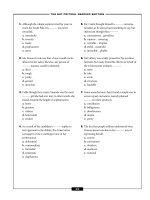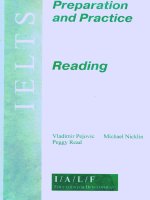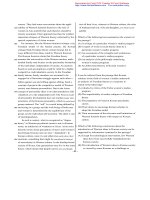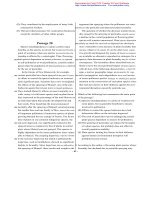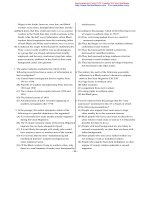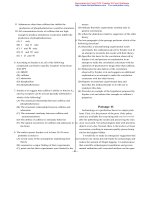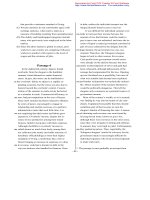Reading Train 1 Teachers Manual
Bạn đang xem bản rút gọn của tài liệu. Xem và tải ngay bản đầy đủ của tài liệu tại đây (21.83 MB, 55 trang )
An Introduction
to This Book
Reading Train is the intermediate level in the
reading series for elementary school
students. This series focuses on the development of reading skills and vocabulary. A major
feature of this series is the idea of teaching reading in English. This means that reading
becomes a thinking process instead of a translation task. Thus, it is the intention of the
authors that the teacher uses as little translation as possible in the classroom.
However, it must be remembered that effective teaching requires understanding. Making
students understand is the teacher's role. Therefore, the authors are not supporters of a
strict “English only” environment in the classroom. We believe that the teacher should feel
free to use the student's first language as and when required. Nonetheless, use of the first
language should not be a substitute for good lesson planning and a sound teaching strategy.
Text Selection
When preparing for any reading class, it is the teacher's responsibility to assess their student's
English ability and choose the reading text which best fits their student's needs. If the text
requires a lot of translation to be understood, it is probably too difficult. The teacher should
replace it with an easier text in this or another series.
Independent Reading
While teaching reading, it is important that students have a chance to read the passage
independently, at their own pace. By becoming an independent reader, students can begin
to enjoy reading for pleasure. Reading for pleasure is a very effective way of becoming
fluent in a language.
Independent reading puts great demands on lesson planning because of the differing
abilities of students. Some students will finish reading before others. Therefore, supplementary
activities should be prepared that allow the teacher to occupy fast finishers. One possible
method is to use the During Reading exercises in the Reading Train student book as
supplementary material. Let the fast finishers work through the exercises independently,
while the less able students catch up. The slower students could do the exerises for homework.
During the Lesson
It is a good idea to teach the students some basic strategies that will reduce their
dependence on the teacher while they read independently.
These could include:
1) Phonics: Decoding an unfamiliar word phonetically could help students to recognize its
meaning.
2) Using a Dictionary: Make electronic or paper dictionaries available in the classroom. This
will allow students to investigate the meaning of words they don't know.
3) Peer questioning: If a student doesn't understand a word or phrase, they should ask their
friend first. This reduces dependence on the teacher and creates a
learning opportunity for both students.
It is worthwhile reviewing these strategies regularly. During independent reading, monitor
the students and use appropriate prompts to encourage their use. Praise the correct use of
these strategies.
Throughout the Reading Rocket series, the following reading skills are practiced to help
students understand the passage better:
Skill 0
Scanning for information
Skill 1
Identifying main ideas
Skill 2
Identifying feelings and attitudes
Skill 3
Identifying details
Skill 4
Identifying cohesion - pronouns
Skill 5
Making inferences
Skill 6
Identifying cause and effect
Skill 7
Understanding the order of events (sequencing)
Skill 8
Identifying facts
Skill 9
Compare and contrast
Skill 10
Problem and solution
Help students to make these reading skills part of their reading strategies too. Encourage
students to use them regularly when they read something new.
Time to Sing
Warm up
In this section, students should predict and imagine
what they are going to read about by looking at the
illustration which accompanies the passage.
I can see some students and a teacher.
Jay is singing.
Because Jay is singing badly/loudly.
Review related vocabulary and help students to express
what is happening in the illustration.
Guide students through the warm-up questions, and
have students answer in English.
sing
0
loudly
0
science
0
quietly
0
Learn the New Words
Have students think about the answers.
Ask students to choose the correct answers and write
them in the blanks.
Check to see if students have fully understood the
meaning of the words they learned.
Find the Main Idea
Ask students to read the passage. Check their
understanding.
Have students circle the main idea of the story.
Practice the Reading Skills
In this section, students will improve their reading
proficiency and thinking ability by studying the specific
READING SKILLS that are listed below.
While doing the activity, encourage students to refer
back to the passage as many times as they need to.
Give students time to do the exercises. Assist them as
required.
1. Read the story again and complete the chart.
1 Reading Skill -> Organizing information
2. Circle the correct answer.
1 Reading Skill -> Identifying cohesion: pronouns
2 Reading Skill -> Identifying cohesion: pronouns
3 Reading Skill -> Identifying feelings and attitudes
4 Reading Skill -> Identifying details
5 Reading Skill -> Identifying details
Book 1
6
hurt
0
Check Your Understanding
Ask students to open their textbooks to page 12.
school
English
math
science
music
Have students read the sentences and check True or
False based on the passage.
Check the answers individually or as a group.
Practice the New Words and Grammar
1. Choose and write.
Ask students to choose the correct words from the
word bank and fill in the blanks.
Check if students have understood the meaning of the
words and are able to use them in different contexts.
2. Find the mistake and correct it.
Have students understand the GRAMMAR RULES
used in the passage.
1 Present simple tense
He sleeps in a bed.
2 Present simple tense: negation
She doesn't know the answer.
3 Adverb
Run quickly! He laughed happily.
4 Past progressive tense
She was reading a book.
Write about Yourself
This section is designed to help students extend the
ideas in the passage by drawing on their own
experiences and knowledge. Help them to express their
opinion naturally in complete sentences, using the
words they learned.
sing
science
loudly
hurt
If students have difficulty writing sentences in English,
the teacher should have them discuss the questions
orally before they begin writing.
quietly
doesn’t
loudly
singing
Yes, I do. / No I don’t.
Yes, I am. / No I’m not.
Workbook 1: pages 6~7
The answer key to the homework is found on page 46 in
the Teacher's Manual.
I like science.
Reading Train 1
Book 1
7
Insects in the Classroom
Ask the students to open their workbooks to pages 6~7.
Check the homework by having students take turns
calling out the answers.
I can see some ants, some crickets and a beetle.
They are studying science/insects.
She likes them.
Warm up
In this section, students should predict and imagine
what they are going to read about by looking at the
illustration which accompanies the passage.
Review related vocabulary and help students to express
what is happening in the illustration.
kid
scared
last
insect
Guide students through the warm-up questions, and
have students answer in English.
Learn the New Words
Have students think about the answers.
Ask students to choose the correct answers and write
them in the blanks.
Check to see if students have fully understood the
meaning of the words they learned.
Find the Main Idea
Ask students to read the passage. Check their
understanding.
Have students circle the main idea of the story.
Practice the Reading Skills
In this section, students will improve their reading
proficiency and thinking ability by studying the specific
READING SKILLS that are listed below.
While doing the activity, encourage students to refer
back to the passage as many times as they need to.
Give students time to do the exercises. Assist them as
required.
1. Read the story again and complete the chart.
1 Reading Skill -> Organizing information
2. Circle the correct answer.
1 Reading Skill -> Identifying cohesion: pronouns
2 Reading Skill -> Identifying cohesion: pronouns
3 Reading Skill -> Identifying feelings and attitudes
4 Reading Skill -> Identifying details
5 Reading Skill -> Identifying details
Book 1
8
tank
Check Your Understanding
crickets
beetle
ants
Ask students to open their textbooks to page 16.
Have students read the sentences and check True or
False based on the passage.
Check the answers individually or as a group.
Practice the New Words and Grammar
1. Choose and write.
Ask students to choose the correct words from the
word bank and fill in the blanks.
Check if students have understood the meaning of the
words and are able to use them in different contexts.
2. Find the mistake and correct it.
Have students understand the GRAMMAR RULES
used in the passage.
1 Present progressive tense: question
What are you doing now?
2 Noun: plural count
I have five pencils.
3 Noun: plural count
Some flowers are on the table.
4 To-infinitive with a transitive verb
I want to eat a strawberry cake.
Write about Yourself
This section is designed to help students extend the
ideas in the passage by drawing on their own
experiences and knowledge. Help them to express their
opinion naturally in complete sentences, using the
words they learned.
kid
insect
scared
tank
If students have difficulty writing sentences in English,
the teacher should have them discuss the questions
orally before they begin writing.
last
tanks
are
learn
My favorite insect is the ant.
They eat apples.
Workbook 1: pages 8~9
The answer key to the homework is found on page 46 in
the Teacher's Manual.
Yes, I do. / No, I don’t.
Reading Train 1
Book 1
9
BMX!
Ask the students to open their workbooks to pages 8~9.
Check the homework by having students take turns
calling out the answers.
Anna is in the garden.
Anna is riding a bicycle. / Anna is talking to Uncle Ted.
Anna is happy.
Warm up
In this section, students should predict and imagine
what they are going to read about by looking at the
illustration which accompanies the passage.
Review related vocabulary and help students to express
what is happening in the illustration.
scratch
yesterday
tire
daughter
Guide students through the warm-up questions, and
have students answer in English.
Learn the New Words
Have students think about the answers.
Ask students to choose the correct answers and write
them in the blanks.
Check to see if students have fully understood the
meaning of the words they learned.
Find the Main Idea
Ask students to read the passage. Check their
understanding.
Have students circle the main idea of the story.
Practice the Reading Skills
In this section, students will improve their reading
proficiency and thinking ability by studying the specific
READING SKILLS that are listed below.
While doing the activity, encourage students to refer
back to the passage as many times as they need to.
Give students time to do the exercises. Assist them as
required.
1. Read the story again and complete the chart.
1 Reading Skill -> Organizing information
2. Circle the correct answer.
1 Reading Skill -> Identifying cohesion: pronouns
2 Reading Skill -> Identifying cohesion: pronouns
3 Reading Skill -> Identifying feelings and attitudes
4 Reading Skill -> Identifying details
5 Reading Skill -> Identifying details
Book 1
10
uncle
Check Your Understanding
Ask students to open their textbooks to page 20.
Have students read the sentences and check True or
False based on the passage.
Check the answers individually or as a group.
Practice the New Words and Grammar
1. Choose and write.
Ask students to choose the correct words from the
word bank and fill in the blanks.
Check if students have understood the meaning of the
words and are able to use them in different contexts.
2. Find the mistake and correct it.
Have students understand the GRAMMAR RULES
used in the passage.
1 Past simple tense
I was sick yesterday.
2 Future simple tense: be going to
We are going to have dinner.
3 Adverb
slow - slowly simple - simply beautiful - beautifully
4 Noun: plural count
The students were very excited.
Write about Yourself
This section is designed to help students extend the
ideas in the passage by drawing on their own
experiences and knowledge. Help them to express their
opinion naturally in complete sentences, using the words
they learned.
tire
uncle
scratch
yesterday
If students have difficulty writing sentences in English,
the teacher should have them discuss the questions
orally before they begin writing.
daughter
was
ride
happily
were
Yes, I can. / No, I can’t.
Yes, I do. / No, I don’t.
Workbook 1: pages 10~11
The answer key to the homework is found on page 47 in
the Teacher's Manual.
I want to go to the park.
Reading Train 1
Book 1
11
The Picky Eater
Ask the students to open their workbooks to pages 10~11.
Check the homework by having students take turns
calling out the answers.
I like fruit but I dislike onions.
A picky eater is someone who doesn’t like many foods.
The panda is eating bamboo.
Warm up
In this section, students should predict and imagine
what they are going to read about by looking at the
illustration which accompanies the passage.
Review related vocabulary and help students to express
what is happening in the illustration.
peach
egg
pear
panda
Guide students through the warm-up questions, and
have students answer in English.
Learn the New Words
Have students think about the answers.
Ask students to choose the correct answers and write
them in the blanks.
Check to see if students have fully understood the
meaning of the words they learned.
Find the Main Idea
Ask students to read the passage. Check their
understanding.
Have students circle the main idea of the story.
Practice the Reading Skills
In this section, students will improve their reading
proficiency and thinking ability by studying the specific
READING SKILLS that are listed below.
While doing the activity, encourage students to refer
back to the passage as many times as they need to.
Give students time to do the exercises. Assist them as
required.
1. Read the story again and complete the chart.
1 Reading Skill -> Organizing information
2. Circle the correct answer.
1 Reading Skill -> Identifying cohesion: pronouns
2 Reading Skill -> Identifying cohesion: pronouns
3 Reading Skill -> Identifying feelings and attitudes
4 Reading Skill -> Identifying details
5 Reading Skill -> Making inferences
Book 1
12
bamboo
Check Your Understanding
No
No
Ask students to open their textbooks to page 24.
No
No
No
No
No
Yes
Have students read the sentences and check True or
False based on the passage.
Check the answers individually or as a group.
Practice the New Words and Grammar
1. Look and match.
Ask students to choose the correct words from the
word bank and fill in the blanks.
Check if students have understood the meaning of the
words and are able to use them in different contexts.
2. Find the mistake and correct it.
Have students understand the GRAMMAR RULES
used in the passage.
1 Present simple tense: negation
He doesn't have the book.
2 Present simple tense
He drinks milk every day.
3 Noun: plural count
baby - babies
city - cities
story - stories
4 Helping verb: negation
She will not watch TV.
Write about Yourself
This section is designed to help students extend the
ideas in the passage by drawing on their own
experiences and knowledge. Help them to express their
opinion naturally in complete sentences, using the
words they learned.
If students have difficulty writing sentences in English,
the teacher should have them discuss the questions
orally before they begin writing.
doesn’t
eats
Strawberries
look
Yes, I have. / No, I haven’t.
Workbook 1: pages 12~13
The answer key to the homework is found on page 47 in
the Teacher's Manual.
Yes, I am. / No, I’m not.
My favorite food is pizza.
Reading Train 1
Book 1
13
My Silly New Dog
Ask the students to open their workbooks to pages 12~13.
Check the homework by having students take turns
calling out the answers.
The dog is singing a song, wagging its tail, running, and sleeping.
The boy is not happy with the dog.
The dog is sleeping on the boy’s feet.
Warm up
In this section, students should predict and imagine
what they are going to read about by looking at the
illustration which accompanies the passage.
Review related vocabulary and help students to express
what is happening in the illustration.
funny
find
silly
proud
Guide students through the warm-up questions, and
have students answer in English.
Learn the New Words
Have students think about the answers.
Ask students to choose the correct answers and write
them in the blanks.
Check to see if students have fully understood the
meaning of the words they learned.
Find the Main Idea
Ask students to read the passage. Check their
understanding.
Have students circle the main idea of the story.
Practice the Reading Skills
In this section, students will improve their reading
proficiency and thinking ability by studying the specific
READING SKILLS that are listed below.
While doing the activity, encourage students to refer
back to the passage as many times as they need to.
Give students time to do the exercises. Assist them as
required.
1. Read the story again and complete the chart.
1 Reading Skill -> Organizing information
2. Circle the correct answer.
1 Reading Skill -> Identifying cohesion: pronouns
2 Reading Skill -> Identifying cohesion: pronouns
3 Reading Skill -> Identifying feelings and attitudes
4 Reading Skill -> Identifying details
5 Reading Skill -> Identifying details
Book 1
14
chase
Check Your Understanding
Ask students to open their textbooks to page 28.
Have students read the sentences and check True or
False based on the passage.
Check the answers individually or as a group.
Practice the New Words and Grammar
1. Choose and write.
Ask students to choose the correct words from the
word bank and fill in the blanks.
Check if students have understood the meaning of the
words and are able to use them in different contexts.
2. Find the mistake and correct it.
Have students understand the GRAMMAR RULES
used in the passage.
1 Present simple tense
She works at a bank.
2 Past simple tense: irregular verb
bring - brought
have - had
think - thought
3 To-infinitive with a transitive verb
John likes to play the piano.
4 Present simple tense
He plays baseball every Sunday.
Write about Yourself
This section is designed to help students extend the
ideas in the passage by drawing on their own
experiences and knowledge. Help them to express their
opinion naturally in complete sentences, using the
words they learned.
find
silly
chase
funny
If students have difficulty writing sentences in English,
the teacher should have them discuss the questions
orally before they begin writing.
proud
likes
brought
likes to
smiles
Yes, I do. / No, I don’t.
Workbook 1: pages 14~15
The answer key to the homework is found on page 48 in
the Teacher's Manual.
Yes, I do. / No, I don’t.
I jump on the sofa. I swim in the bath.
I make ice-cream sandwiches.
Reading Train 1
Book 1
15
The Moon Gets a Friend
Ask the students to open their workbooks to pages 14~15.
Check the homework by having students take turns
calling out the answers.
I can see an owl.
The moon feels lonely and happy.
The owl is looking at the moon.
Warm up
In this section, students should predict and imagine
what they are going to read about by looking at the
illustration which accompanies the passage.
Review related vocabulary and help students to express
what is happening in the illustration.
together
awake
alone
far
Guide students through the warm-up questions, and
have students answer in English.
Learn the New Words
Have students think about the answers.
Ask students to choose the correct answers and write
them in the blanks.
Check to see if students have fully understood the
meaning of the words they learned.
Find the Main Idea
Ask students to read the passage. Check their
understanding.
Have students circle the main idea of the story.
Practice the Reading Skills
In this section, students will improve their reading
proficiency and thinking ability by studying the specific
READING SKILLS that are listed below.
While doing the activity, encourage students to refer
back to the passage as many times as they need to.
Give students time to do the exercises. Assist them as
required.
1. Read the story again and complete the chart.
1 Reading Skill -> Organizing information
2. Circle the correct answer.
1 Reading Skill -> Identifying cohesion: pronouns
2 Reading Skill -> Identifying cohesion: pronouns
3 Reading Skill -> Identifying details
4 Reading Skill -> Identifying feelings and attitudes
5 Reading Skill -> Making inferences
Book 1
16
voice
Check Your Understanding
Ask students to open their textbooks to page 32.
Have students read the sentences and check True or
False based on the passage.
sad
lonely
happy
Check the answers individually or as a group.
Practice the New Words and Grammar
1. Choose and write.
Ask students to choose the correct words from the
word bank and fill in the blanks.
Check if students have understood the meaning of the
words and are able to use them in different contexts.
2. Choose and write.
Have students understand the GRAMMAR RULES
used in the passage.
1 Present simple tense
They are my friends.
2 Future simple tense: will
She will go to school.
3 “Every~” with singular verb
Everybody likes the actor.
4 Present simple tense
I am a student.
Write about Yourself
far
awake
alone
together
voice
This section is designed to help students extend the
ideas in the passage by drawing on their own
experiences and knowledge. Help them to express their
opinion naturally in complete sentences, using the
words they learned.
If students have difficulty writing sentences in English,
the teacher should have them discuss the questions
orally before they begin writing.
are
be
is
am
Workbook 1: pages 18~19
Yes, I do. / No, I don’t.
The answer key to the homework is found on page 48 in
the Teacher's Manual.
My best friend is George.
Yes, I do. / No, I don’t.
Reading Train 1
Book 1
17
Sleepy Jay
Ask the students to open their workbooks to pages 18~19.
Check the homework by having students take turns
calling out the answers.
Jay is at the crosswalk, in bed and at school.
Jay is sleeping, walking and sitting in bed.
No, he is not sleeping in bed.
Warm up
In this section, students should predict and imagine
what they are going to read about by looking at the
illustration which accompanies the passage.
Review related vocabulary and help students to express
what is happening in the illustration.
breakfast
bookshop
restaurant
sleepy
Guide students through the warm-up questions, and
have students answer in English.
Learn the New Words
Have students think about the answers.
Ask students to choose the correct answers and write
them in the blanks.
Check to see if students have fully understood the
meaning of the words they learned.
Find the Main Idea
Ask students to read the passage. Check their
understanding.
Have students circle the main idea of the story.
Practice the Reading Skills
In this section, students will improve their reading
proficiency and thinking ability by studying the specific
READING SKILLS that are listed below.
While doing the activity, encourage students to refer
back to the passage as many times as they need to.
Give students time to do the exercises. Assist them as
required.
1. Read the story again and complete the chart.
1 Reading Skill -> Organizing information
2. Circle the correct answer.
1 Reading Skill -> Identifying cohesion: pronouns
2 Reading Skill -> Identifying cohesion: pronouns
3 Reading Skill -> Identifying feelings and attitudes
4 Reading Skill -> Identifying details
5 Reading Skill -> Identifying details
Book 1
18
textbook
Check Your Understanding
Ask students to open their textbooks to page 36.
textbook
blackboard
crosswalk
restaurant
bookshop
church
Have students read the sentences and check True or
False based on the passage.
Check the answers individually or as a group.
Practice the New Words and Grammar
1. Choose and write.
Ask students to choose the correct words from the
word bank and fill in the blanks.
Check if students have understood the meaning of the
words and are able to use them in different contexts.
2. Find the mistake and correct it.
Have students understand the GRAMMAR RULES
used in the passage.
1 Present simple tense
I am happy now.
2 Past simple tense: irregular verb
fall - fell
buy - bought
feel - felt
3 Past simple tense
She was sick yesterday.
4 Past simple tense: irregular verb
sleep - slept
lose - lost
make - made
Write about Yourself
This section is designed to help students extend the
ideas in the passage by drawing on their own
experiences and knowledge. Help them to express their
opinion naturally in complete sentences, using the
words they learned.
breakfast
bookshop
textbook
If students have difficulty writing sentences in English,
the teacher should have them discuss the questions
orally before they begin writing.
restaurant
sleepy
am
fell
was
slept
Yes, I am. / No, I’m not.
Workbook 1: pages 20~21
The answer key to the homework is found on page 49 in
the Teacher's Manual.
I usually go to bed at 9:00 p.m.
Yes, I did. / No, I didn’t.
Reading Train 1
Book 1
19
Vacation
Ask the students to open their workbooks to pages 20~21.
Check the homework by having students take turns
calling out the answers.
The family is in a garden and on a plane.
They are talking.
Anna is holding a book.
Warm up
In this section, students should predict and imagine
what they are going to read about by looking at the
illustration which accompanies the passage.
Review related vocabulary and help students to express
what is happening in the illustration.
library
hotel
family
vacation
Guide students through the warm-up questions, and
have students answer in English.
Learn the New Words
Have students think about the answers.
Ask students to choose the correct answers and write
them in the blanks.
Check to see if students have fully understood the
meaning of the words they learned.
Find the Main Idea
Ask students to read the passage. Check their
understanding.
Have students circle the main idea of the story.
Practice the Reading Skills
In this section, students will improve their reading
proficiency and thinking ability by studying the specific
READING SKILLS that are listed below.
While doing the activity, encourage students to refer
back to the passage as many times as they need to.
Give students time to do the exercises. Assist them as
required.
1. Read the story again and complete the chart.
1 Reading Skill -> Organizing information
2. Circle the correct answer.
1 Reading Skill -> Identifying cohesion: pronouns
2 Reading Skill -> Identifying cohesion: pronouns
3 Reading Skill -> Identifying details
4 Reading Skill -> Identifying details
5 Reading Skill -> Identifying details
Book 1
20
garden
Check Your Understanding
library
Ask students to open their textbooks to page 40.
museum
Have students read the sentences and check True or
False based on the passage.
garden
Check the answers individually or as a group.
hotel
Practice the New Words and Grammar
1. Choose and write.
Ask students to choose the correct words from the
word bank and fill in the blanks.
Check if students have understood the meaning of the
words and are able to use them in different contexts.
2. Find the mistake and correct it.
Have students understand the GRAMMAR RULES
used in the passage.
1 Past progressive tense
They were swimming in the pool.
2 Future simple tense: be ~ing
He's arriving tomorrow.
3 Gerund used as an object
We stopped talking.
4 To-infinitive with a transitive verb
I want to play soccer.
Write about Yourself
This section is designed to help students extend the
ideas in the passage by drawing on their own
experiences and knowledge. Help them to express their
opinion naturally in complete sentences, using the
words they learned.
vacation
library
hotel
garden
If students have difficulty writing sentences in English,
the teacher should have them discuss the questions
orally before they begin writing.
family
were
going
reading
want to
Yes, I do. / No, I don’t.
Workbook 1: pages 22~23
The answer key to the homework is found on page 49 in
the Teacher's Manual.
I usually read in my room.
I read many comic books.
Reading Train 1
Book 1
21
E-mails
Ask the students to open their workbooks to pages 22~23.
Check the homework by having students take turns
calling out the answers.
Anna is using a computer.
The woman is sending an e-mail.
They feel happy.
Warm up
In this section, students should predict and imagine
what they are going to read about by looking at the
illustration which accompanies the passage.
Review related vocabulary and help students to express
what is happening in the illustration.
computer
letter
easy
Guide students through the warm-up questions, and
have students answer in English.
Learn the New Words
Have students think about the answers.
Ask students to choose the correct answers and write
them in the blanks.
Check to see if students have fully understood the
meaning of the words they learned.
Find the Main Idea
Ask students to read the passage. Check their
understanding.
Have students circle the main idea of the story.
Practice the Reading Skills
In this section, students will improve their reading
proficiency and thinking ability by studying the specific
READING SKILLS that are listed below.
While doing the activity, encourage students to refer
back to the passage as many times as they need to.
Give students time to do the exercises. Assist them as
required.
1. Read the story again and complete the chart.
1 Reading Skill -> Organizing information
2. Circle the correct answer.
1 Reading Skill -> Identifying cohesion: pronouns
2 Reading Skill -> Identifying cohesion: pronouns
3 Reading Skill -> Identifying details
4 Reading Skill -> Identifying details
5 Reading Skill -> Identifying feelings and attitudes
Book 1
22
send
Check Your Understanding
Ask students to open their textbooks to page 44.
Have students read the sentences and check True or
False based on the passage.
X
O
Check the answers individually or as a group.
Practice the New Words and Grammar
1. Choose and write.
Ask students to choose the correct words from the
word bank and fill in the blanks.
Check if students have understood the meaning of the
words and are able to use them in different contexts.
2. Find the mistake and correct it.
Have students understand the GRAMMAR RULES
used in the passage.
1 Past simple tense: irregular verb
hear - heard know - knew go - went
2 Gerund used as a subject
Playing soccer is interesting.
3 To-infinitive with a transitive verb
I always try to be a good friend.
4 Past simple tense: negation
I didn't hear that news.
Write about Yourself
This section is designed to help students extend the
ideas in the passage by drawing on their own
experiences and knowledge. Help them to express their
opinion naturally in complete sentences, using the
words they learned.
send
letter
computer
If students have difficulty writing sentences in English,
the teacher should have them discuss the questions
orally before they begin writing.
easy
heard
Using
like to
get
Yes, I do. / No, I don’t.
Workbook 1: pages 24~25
The answer key to the homework is found on page 50 in
the Teacher's Manual.
Yes, I do. / No, I don’t.
I think the best way is to phone her.
Reading Train 1
Book 1
23
The Busy Firefighters
Ask the students to open their workbooks to pages 24~25.
Check the homework by having students take turns
calling out the answers.
The building is on fire. The firefighters are
fighting the fire.
They are putting out / fighting the fire.
Warm up
In this section, students should predict and imagine
what they are going to read about by looking at the
illustration which accompanies the passage.
Review related vocabulary and help students to express
what is happening in the illustration.
ring(rang)
fire
spray
brave
Guide students through the warm-up questions, and
have students answer in English.
Learn the New Words
Have students think about the answers.
Ask students to choose the correct answers and write
them in the blanks.
Check to see if students have fully understood the
meaning of the words they learned.
Find the Main Idea
Ask students to read the passage. Check their
understanding.
Have students circle the main idea of the story.
Practice the Reading Skills
In this section, students will improve their reading
proficiency and thinking ability by studying the specific
READING SKILLS that are listed below.
While doing the activity, encourage students to refer
back to the passage as many times as they need to.
Give students time to do the exercises. Assist them as
required.
1. Read the story again and complete the chart.
1 Reading Skill -> Organizing information
2. Circle the correct answer.
1 Reading Skill -> Identifying cohesion: pronouns
2 Reading Skill -> Identifying cohesion: pronouns
3 Reading Skill -> Identifying details
4 Reading Skill -> Identifying details
Book 1
24
firefighter
Check Your Understanding
Ask students to open their textbooks to page 48.
Have students read the sentences and check True or
False based on the passage.
woke
slid
rushed
Check the answers individually or as a group.
helped
sprayed
Practice the New Words and Grammar
1. Choose and write.
Ask students to choose the correct words from the
word bank and fill in the blanks.
Check if students have understood the meaning of the
words and are able to use them in different contexts.
2. Find the mistake and correct it.
Have students understand the GRAMMAR RULES
used in the passage.
1 Past simple tense: irregular verb
ring - rang give - gave have - had
2 Past simple tense: irregular verb
wake - woke
run - ran
ride - rode
3 Past progressive tense
She was reading a newspaper.
4 Gerund used as a subject
Keeping your promise is important.
Write about Yourself
This section is designed to help students extend the
ideas in the passage by drawing on their own
experiences and knowledge. Help them to express their
opinion naturally in complete sentences, using the
words they learned.
ringing
sprayed
Firefighters
If students have difficulty writing sentences in English,
the teacher should have them discuss the questions
orally before they begin writing.
brave
fire
rang
woke
burning
Putting
Yes, I do. / No, I don’t.
Workbook 1: pages 26~27
The answer key to the homework is found on page 50 in
the Teacher's Manual.
Yes, I am. / No, I’m not.
I should call _________.
Reading Train 1
Book 1
25


